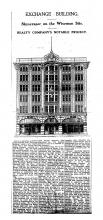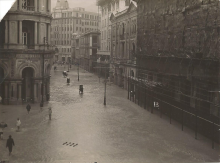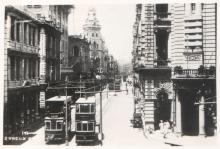Exchange Building / Exchange House / Telephone House / Lane Crawford House [1926-1977]
Primary tabs
14, Des Voeux Road.
The building opened in 1926, and was the site of Lane Crawford's new store. Lane Crawford moved here from their Ice House Street premises, and occupied the lower two floors. (Source: newspaper clipping)
Brian has posted a photo of the building (see photo 3b).
Does anyone know when it was demolished?
This 1960s map shows the building on this site is called 'Telephone House', but still houses Lane Crawford. I'm not sure if it is the same building, re-named, or a later building.
Regards, David





Comments
Re: Exchange Building / House
The 1926 building stood until 1976 or 1977 (exact year should appear in the Hongkong Land history book), and it is also called "Lane Crawford House." I am not sure what the official name of the building is though.
exchange building/ Lane Crawford House
yep 1977 you can go with, same year as demolition of adjacent Gloucester Building while the new Lane Crawford House opened on 70 Queens Road the same year.
the government public records office has a few photos taken from 1977 of the building as well as Gloucester Building ahead of their demolition. You can see it's called Lane Crawford House.
http://www.grs.gov.hk/PRO/imgroot/1-11/1-11-287.jpg
http://www.grs.gov.hk/PRO/imgroot/1-11/1-11-288.jpg
http://www.grs.gov.hk/PRO/imgroot/1-11/1-11-289.jpg
re: Exchange building / Lane Crawford House
C & 80sKid, thanks for the extra info, I've updated the year and name (it's a bit of a mouthful now!).
Thanks also to Andrew Tse for the following message, sent by email:
This building was known to me as Lane Crawford House. That's the Lane Crawford Department Store. It was very beautiful, unusual because it had a lot of moulding and decorative objects at the facade. Beige in color. Exactly the same as the one in your photo.
I remember there was a super market by the name of Dairy Lane, possibly a joint venture between Dairy Farm and Lane Crawford. That was one of the very few super market in HK. Later, in the mid 70's Dairy Farm acquired Welcome, a local supermarket located at Pedder Building and expanded using Welcome as its new brand name.
Lane Crawford later became a member of the Wheelock Group. In the late 70's HK Land wanted to build the Landmark, and swapped Jardine House for Lane Crawford House. Jardine House was situated at the corner of Pedder St and Des Voeux Rd. Today, Wheelock House occupies the site of the former Jardine House.
When Lane Crawford House was demolished to make way for the Landmark, Lane Crawford Dept. Store moved to a new building in Queen's Road Central. I think the site was the former China Emporium Dept. Store., possibly another Wheelock Group company.
The Landmark site was formerly occupied by the Gloucester Building, Edinburgh House, Windsor House and Lane Crawford House. [Admin: also Marina House]
Looking west along the north side of Des Voeux Rd, you'd see the Bank of East Asia / Windsor House / a lane / Lane Crawford House / a lane / Gloucester Building / Pedder Street.
And looking west along the south side on Queen's Road, you'd see Edinburgh House / Marina House / a lane / Central Building
Maxim group had its first dining room in the area - not sure exactly where though, could be at the basement of Lane Crawford Hse.
It's good to have all this
It's good to have all this information and some better photos.
The Wikipedia article on The Landmark says that the site of the Hong Kong Hotel was part of the development - how does that fit in?
http://en.wikipedia.org/wiki/The_Landmark_(Hong_Kong)
Landmark / Hong Kong Hotel
Hi Brian, The Wiki entry isn't exactly wrong, as the old Hong Kong Hotel was on this block. But there was another generation of buildings between the Hong Kong Hotel and the Landmark, and it's that generation of buildings we're describing here.
Regards, David
Thanks, David. Please bear
Thanks, David.
Please bear with me if I'm being slow: I've learnt elsewhere on Gwulo that the Hong Kong Hotel survived until 1952, so the buildings under discussion were erected on the part that was redeveloped after a fire in 1926 - is this correct?
(Note: After the 1941 surrender people in the Gloucester Hotel were not allowed on the streets but 'could go through the arcade into the Hong Kong Hotel' - Phyllis Harrop, Hong Kong Incident, 88).
Hong Kong Hotel / Gloucester Hotel
Hi Brian, don't worry, I'm still getting the changing layout of that block clear in my mind too. Here's a map that should help:
It shows the buildings we've been talking about, alongside the tramlines.
You're right that the Gloucester Building is on the site of the section of the Hong Kong Hotel that was damaged by fire.
The part of the Hong Kong Hotel that was still there in the 1940s stood where the 'Central Building' is shown on this map.
Regards, David
Thanks, David. The map's very
Thanks, David. The map's very helpful. But is it a coincidence that the HK hotel fire was in 1926, the year Exchange House was built? If not, and Lane Crawford redeveloped the damaged part of the hotel, then things moved pretty fast in the Hong Kong construction industry in those days!
And here are a few more aspects of the history of this area:
1) (Other looters) were dispatched with a shot in the back of the neck by the British police in a cul-de-sac running between the Gloucester Hotel and Lane Crawford's department store which became known as Blood Alley.
Philip Snow, The Fall of Hong Kong, 61.
2) In the meantime, however, the official attitude was "Chins up!", and in the various departments on Christmas Day {1941} the workers wondered if the Cafe Wiseman would have turkey and plum pudding for tiffin. It had. And a Christmas tree!
Thomas F. Ryan, Jesuits Under Fire in the Siege of Hong Kong 1941, 168
3) {Dec. 26th.}The Hong Kong Bank Building, Lane Crawfords, Exchange Building and many of the large buildings are flying the Rising Sun, also Murray Barracks and the Naval Dockyard. On top of our building {Gloucester Hotel} and the Exchange Building are two large white sheets, attached to the flag poles. There is no breeze and they look a sorry spectacle.
Phyllis Harrop, Hong Kong Incident, 89.
(I assume the sheets were stuck up as a white flag of surrender - but why didn't the Japanese take them down when they raised the Rising Sun?)
Exchange House
Hi Brian,
But is it a coincidence that the HK hotel fire was in 1926, the year Exchange House was built?
Yes, just a coincidence. If you scroll up to the top, you'll see the newspaper clipping is from 1924, showing what this building would look like when it was finished.
Hong Kong's buildings go up fast, but not that fast!
Regards, David
Exchange House Opening Ceremony (1): Speeches
On Tuesday, August 17, 1926, the ‘streets were lined with an expectant throng’ as people waited for the arrival of Governor Cecil Clementi who was going to open Exchange House.
After the ceremony, in which His Excellency unlocked the door and pulled a cord which released the drapes on the lower part of the building, there were speeches in the Cafe.
Director A. S. D. Cousland made a speech of welcome in which he referred to Lane, Crawford’s origins as a humble matshed on the sea front and pointed out that last year the company had celebrated its 75th anniversary and was now a Hong Kong institution. He told the audience that ‘The many departments of the business are now assembled under one roof’. Not all of the showrooms were complete because of the British general strike, but he promised they soon would be.
Governor Clementi also mentioned the company’s original role as the only European baker in Hong Kong, supplying bread to the ‘inhabitants’ and the navy. He went on to praise the company’s role during the troubles of 1922-25. When he referred to the way they’d kept supplies going during last month’s ‘terrific rainstorms’ the audience applauded. Clementi went to denounce the Canton Government.
The Governor was then taken on a tour of the premises.
Source: China Mail, August 1926, pages 1 and 12.
Exchange House Opening Ceremony (2) Description of Premises
On page 12 a China Mail reporter described the premises:
‘The centre hall is in two shades of marble and the Stock Exchange and Safety Deposit Hall (in the front part of the basement) has walls panelled in white Italian marble.’
‘The premises opened today include the basement, ground floor, mezzanine and first floors, all of which have been taken by Messrs. Lane, Crawford Ltd., including what was formerly Cafe Wiseman (now Lane, Crawford’s Cafe)’.
The building, he wrote, was not yet complete, but when finished:
‘…the various departments and offices of Lane, Crawford will be accessible by way of the centre hall, the mezzanine floor being entered either from the central office entrance by a marble stairway or by two modern lifts running from the ground floor to the top of the building.’
‘A feature of the windows is that they are of the island type, thus giving more window display than is to be found in almost any other building in Hong Kong. The are modern in every respect, with bronze frames round the plate glass windows. Although the frontage of the building is 92 feet, the actual running feet of display window is over 200 feet.’
‘Several interesting features new to Hong Kong are incorporated in the construction of the building…The whole of the front elevation is carried out in cream terra-cotta blocks. As the building is not built over the sidewalk as is usual in Hong Kong, a bronze canopy with wired glass top is to be constructed at the level of the mezzanine floor extending across the width of the pavement to afford protection from the weather to pedestrians using the sidewalk’.
‘It is with the idea of preserving a clean and attractive front that verandahs have been done with on the building. It is modern in every way…’
Final completion, he wrote, was expected in about a month and was eagerly awaited by other tenants eager to occupy the building: the top floor was reserved for ‘New Central Exchange of the Telephone Company’ and also a portion of the fourth floor for their offices. There was keen competition for the other parts of the building.
Exchange House (3): Questions
1) The new premises were replacing ones on Ice House Street, but Paul Gillingham's At The Peak also has a photo (page 12) of 'The Lane, Crawford, Mody Road, Kowloon' - does anyone know anything about this?
2) Gilingham also has a 1922 photo of the company 'mess' (page 14) - was one built in Exchange House?
Lane Crawford at Mody Road
Hi Brian, not sure what you'd like to know about it? They certainly had stores both sides of the harbour. Here's their introduction in a 1963 guidebook:
Lane, Crawford's is a quality British department store which was established before Abraham Lincoln became President of America. In addition to the Main Store, located in the Hong Kong Central District, there are two branches in Kowloon.
At that time the Kowloon branches were in the Miramar Arcade on kimberley Road, and in the Peninsula Hotel Arcade.
Regards, David
Same building? Re-named, or a later building?
Here is a aspect of the history of this area:
First known as Exchange Building since Hong Kong's first automatic exchange was housed in it, it subsequently became Telephone House and then Lane Crawford House when Hongkong Telephone moved into the newly completed Prince's Building in the 60s.
Yingcheng Zhou, Hong Kong's Telecommunications Story - With Pride in Our Achievements, Communications Association of Hong Kong, 2007, 39
Link 1 Link 2
Exchange Building, renamed Lane Crawford House in 1961.
See:(Original)
Here are a couple more views
Here are a couple more views from the Peak that show the back of the building:
http://gwulo.com/node/5721
http://gwulo.com/node/4802
Regards, David
Can we add 'ML 7 Sec A" to
Can we add 'ML 7 Sec A" and Cafe Wiseman to the title? - And Dent's (East) as a previous place?
1961
1961
Lane Crawford’s directors decide to repurchase Telephone House at 14 Des Voeux Road for the record price of $18.5 million. The building is renamed Lane Crawford House and until 1974, when it is swapped for two properties owned by Hongkong Land, 14-16 Pedder Street and the old Jardine House at the corner of Pedder and Des Voeux Road.